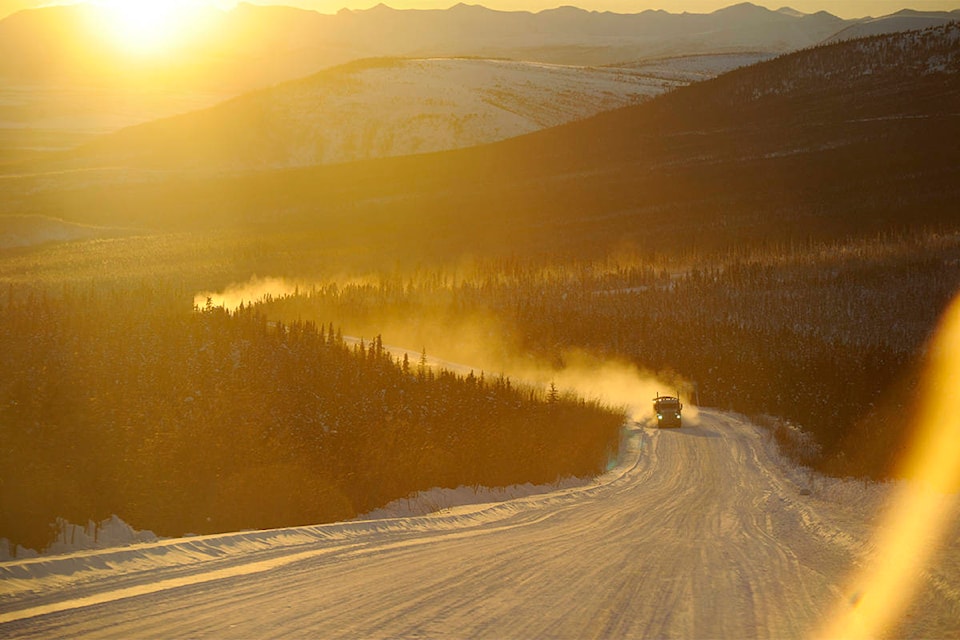The mayor of Inuvik has penned a letter of concern to officials in the Northwest Territories and Yukon urging for better repair and maintenance of the Dempster Highway, particularly around Eagle Plains.
In a Jan. 10 letter addressed to Northwest Territories’ Minister of Infrastructure Katrina Nokleby, Natasha Kulikowski wrote that conditions on the Yukon side of the border this past summer, particularly near Rock River, “were terrible,” noting that two liquid natural gas tankers tipped or went off the road within a week of each other.
The incidents led to multi-day closures that impacted not only Inuvik’s fuel supplies, the letter says, “but also resident’s (sic) travel home, grocery delivery, and so on.”
The Yukon’s minister of Highways and Public Works, Richard Mostyn, Whitehorse Mayor Dan Curtis and Dawson City Mayor Wayne Potoroka are among the officials cc’d on the letter.
In an interview Jan. 23, Kulikowski said that while the highway is relatively stable in the winter when it’s frozen, she’s heard a number of complaints from Inuvik citizens about the conditions on the Dempster over the past two summers, specifically south of Eagle Plains and in the Rock River area.
“The concerns I’ve heard most often, and it’ll sound a little strange, but it’s how slimy the road gets in that area,” she said.
“It’s like a black clay almost on the road and so when there’s been rainy conditions, it’s quite treacherous, right? It’s slimy, like muddy slime, so I think that’s the biggest thing I’ve heard.”
Kulikowski’s letter to officials quotes Inuvik resident Jim McDonald, who, in his own letter to NWT officials in September, wrote that the section of the Dempster south of Eagle Plains was “in the worst condition that I have ever experienced in the thirty-eight years that I have been driving the Dempster Highway.”
In an interview, McDonald told the News that he made the drive to Whitehorse in August and described the stretches around Eagle Plains as “awful” and “deplorable.”
“It was rough and a lot of the base material is up through the surface now, like the bigger rocks and stuff that you wouldn’t normally see, because I don’t think there’s been resurfacing done for some time on that section of the highway,” he said.
“And then north of Eagle, the material that they use on the road there, when it’s wet, it’s very slippery, right? It’s like a clay and really, when it’s wet, the conditions are pretty treacherous in that section.”
Despite the posted speed limit of 90 km/h, McDonald said that for a roughly 100-kilometre stretch south of Eagle Plains, vehicles had to realistically travel at closer to 30 or 40 km/h.
“You couldn’t do 90 on those sections and expect to have a truck when you were finished on it,” he said. “No, it was bad.”
“I do realize there’s a cost in maintaining the road,” he added, “but I do believe … there is funding for road maintenance and the Dempster is part of that, right?”
Kulikowski said she’d like to see the territorial governments on both sides of the border take “greater care on making sure the road is in good condition,” describing the Dempster as a “lifeline” for people living in the Beaufort Delta.
“Because the highway runs to Whitehorse, people from Inuvik do shopping there, they’ll drive there to fly out for cheaper rates, they’ll go play in ball tournaments, you know?” she said.
“… And inversely, almost all of our groceries, dry goods, all of that stuff, comes up that road too as well as the fuel supply for both the (Northwest Territories Power Corporation) and Inuvik Gas, so it’s very important that we have a safe road for people to drive on so we’re not seeing these accidents.”
“Hopefully we see some better road conditions in the coming years.”
Kulikowski said she had not received any responses to her letter from Yukon officials so far.
In an email, Department of Highways and Public Works spokesperson Oshea Jephson said that the minister was aware of Kulikowski’s letter, and that department officials have been in touch with their counterparts in the Northwest Territories about the Dempster. Mostyn, he continued, will also be attending a federal-provinicial-territorial meeting on Feb. 14 where he plans to discuss the issue with federal and territorial officials in-person.
The Department of Highways and Public Works maintains more than 4,800 kilometres of road throughout the territory, Jephson added, 465 kilometres of which are part of the Dempster.
“Maintenance costs on the Dempster Highway are about three times more than other similar highways in the territory due to its remoteness but like all Yukon highways, it is maintained to a safe and appropriate standard given the usage and socioeconomic functions it provides,” he wrote.
“Drivers are reminded to consider these conditions when travelling the Dempster Highway and to always drive to conditions.”
City of Whitehorse spokesperson Myles Dolphin confirmed that Curtis had been in touch with Kulikowski, but as the matter is outside of the city’s jurisdiction, passed on her concerns to Mostyn.
Potoroka confirmed he received the letter, but hasn’t had time to speak to territorial officials about it. He also said he hadn’t heard concerns about the Dempster himself, but acknowledged it’s an “important thoroughfare” and would ask for updates on maintenance from Yukon ministers at upcoming meetings.
The Northwest Territories’ Department of Infrastructure was not able to provide comment before press time.
Contact Jackie Hong at jackie.hong@yukon-news.com
